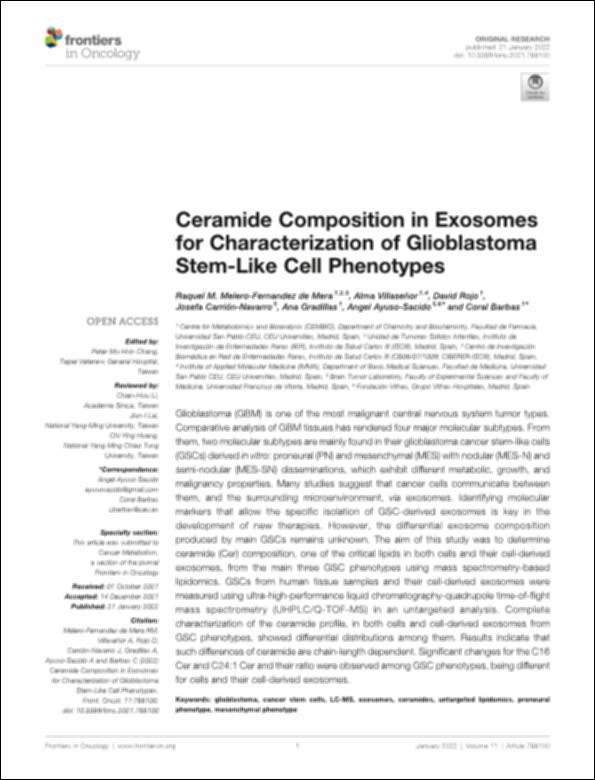Please use this identifier to cite or link to this item:
http://hdl.handle.net/10637/15030Ceramide Composition in Exosomes for Characterization of Glioblastoma Stem-Like Cell Phenotypes
| Title: | Ceramide Composition in Exosomes for Characterization of Glioblastoma Stem-Like Cell Phenotypes |
| Authors : | Melero Fernandez De Mera, Raquel María Villaseñor Solis, Alma Cristina Rojo Blanco, David Carrión-Navarro, Josefa Gradillas Nicolás, Ana Ayuso Sacido, Ángel Barbas Arribas, Coral. |
| Keywords: | Glioblastoma; Cancer stem cells; LC-MS; Exosomes; Ceramides; Untargeted lipidomics; Proneural phenotype; Mesenchymal phenotype |
| Publisher: | Frontiers Media |
| Citation: | Melero-Fernandez de Mera RM, Villaseñor A, Rojo D, Carrio´ n-Navarro J, Gradillas A, Ayuso-Sacido A and Barbas C (2022) Ceramide Composition in Exosomes for Characterization of Glioblastoma Stem-Like Cell Phenotypes. Front. Oncol. 11:788100. doi: 10.3389/fonc.2021.788100 |
| Abstract: | Glioblastoma (GBM) is one of the most malignant central nervous system tumor types. Comparative analysis of GBM tissues has rendered four major molecular subtypes. From them, two molecular subtypes are mainly found in their glioblastoma cancer stem-like cells (GSCs) derived in vitro: proneural (PN) and mesenchymal (MES) with nodular (MES-N) and semi-nodular (MES-SN) disseminations, which exhibit different metabolic, growth, and malignancy properties. Many studies suggest that cancer cells communicate between them, and the surrounding microenvironment, via exosomes. Identifying molecular markers that allow the specific isolation of GSC-derived exosomes is key in the development of new therapies. However, the differential exosome composition produced by main GSCs remains unknown. The aim of this study was to determine ceramide (Cer) composition, one of the critical lipids in both cells and their cell-derived exosomes, from the main three GSC phenotypes using mass spectrometry-based lipidomics. GSCs from human tissue samples and their cell-derived exosomes were measured using ultra-high-performance liquid chromatography-quadrupole time-of-flight mass spectrometry (UHPLC/Q-TOF-MS) in an untargeted analysis. Complete characterization of the ceramide profile, in both cells and cell-derived exosomes from GSC phenotypes, showed differential distributions among them. Results indicate that such differences of ceramide are chain-length dependent. Significant changes for the C16 Cer and C24:1 Cer and their ratio were observed among GSC phenotypes, being different for cells and their cell-derived exosomes. |
| URI: | http://hdl.handle.net/10637/15030 |
| Rights : | http://creativecommons.org/licenses/by-nc-nd/4.0/deed.es Open Access |
| ISSN: | 2234-943X |
| Issue Date: | 21-Feb-2022 |
| Center : | Universidad San Pablo-CEU |
| Appears in Collections: | Facultad de Farmacia |
Items in DSpace are protected by copyright, with all rights reserved, unless otherwise indicated.


